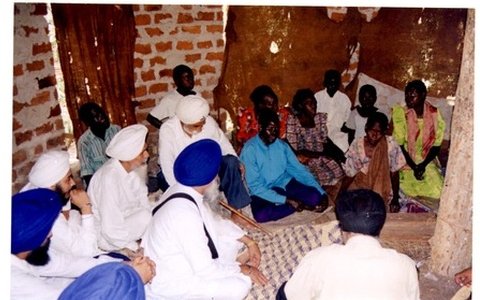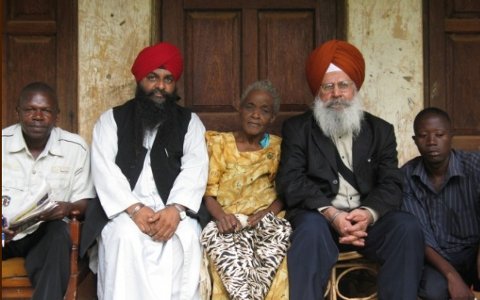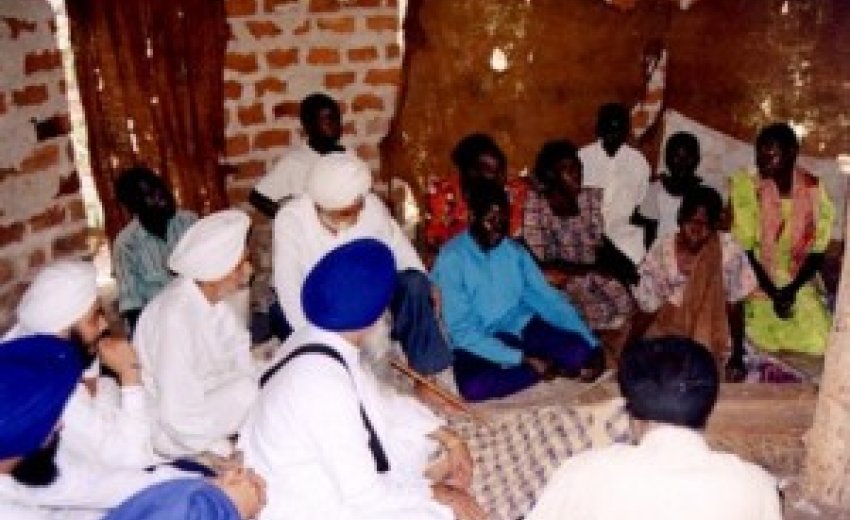24 November, 2015: The following is from a Sikh historian/researcher of Sikh history Bhai Harpal Singh Kasoor and originally published on the Satguru.Weebly Blog.
Anectodal evidence only suggests (of an account) not necessarily true or reliable, because based on personal accounts rather than facts or primary source evidence.
Guru Nanak in Uganda
According to recent research, a new discovery now suggests that Guru Nanak Dev Ji may have traveled as far to the west as East Africa. A small settlement, a hundred miles from Kampala, Uganda, is named ‘Bamu Nanika’ which the locals revere for its spiritual powers. They say that a holy man, not one of their own, sat on a certain spot there and meditated. They say that the spot is covered in a bark-like material and not shown to anyone. Prayers are done in their traditional way. It is also said that all of Uganda ‘s Kabakas (traditional kings) visited the ‘shrine’ to receive blessings upon their advent of rule.
The area is arid with no fresh water for miles. But only a few hundred meters away is a small spring of fresh water which the locals do not allow anyone to drink or use for hand washing. The water is somehow used like ‘giving amrit’ to devotees who are all Africans. When asked about who they revere the place for, the locals said that, “He is not one of ours but there is some great spiritual power here”.
Recently, a number of Gianis from India visited the shrine to research the discovery (it is even believed that, in a sakhi, Bhai Mardana asked Guru Nanak why the locals had curly hair). That faintly suggests that Guru Nanak visited Africa . The locals had no knowledge of Sikhs before our arrival. We are strangers to them. With further research, we feel there is a high possibility of adding Africa to the list of places visited by Guru Nanak.
At a distance of about 12 miles from the Tapora Station, there is a memorial in honour of the visit of Guru Nanak in the hilly forests and about 24 miles from Kampala , there is a village named Bab Nanika. It is here that their history says that the Holy man’s, not of their own, blessings brought forth a spring; they report there had been no water source in the vast area.”
 |
| Giani Gurbachan Singh Verifying Satguru's Visit To Bamunanika, from Local Peoples (By courtesy of Dr. Junoko, Who Served translator from Luanda Language To English). |
Giani Gurbachan Singh Verifying Satguru’s Visit To Bamunanika, from Local Peoples (By courtesy of Dr. Junoko, Who Served translator from Luanda Language To English).
The Great Panthic historian, Bhai Rattan Singh Bhangu, has given an important reference in “Prachin Panth Prakash” of “Desah Wai”(edition, 1998). These ”Desah Wai”, are Kenya, Tanzania and Uganda. These countries speak Swihilli and Luganda languages which were the languages of Bantu Category. ”Wa” in Swahilli means “People of”, similarly “Jumla” and many other words belong to this language which are in Sri Guru Granth Sahib.This great historian has also confirmed that these countries are in the”Paschim” that is in the west.
He is absolutely right in saying that because one earlier historian, named Bhai Sarup Singh Kaushish, in “Guru Kian Sakhian”(1790) has also given a valuable reference of Makhan Shah Lubana. But page 3 of volume-III, of ” A Glossary of The Tribes And Castes of the Punjab and Frontier Province (1911) confirms that the Last Name of Makhan Shah was Pilla, but Lubana was his nickname, because his forefather, Diwan Sawan Mal was Married to Mrs Nambi of Lohana Community of Gujrat. Please note that Makhan Shah was a “Masand” of Gujrat. While narrating his family tree, the writer has stated that—-Baba Makhan Shah s/oDasa, s/oBanna s/oArtha, s/o Bohru Mal, Ulad Sawne Ki. Who is this Sawan Mal ?.
According to the history books of H.A. Rose and others in 1911 (volume-1, 2, 3), have clarified that “Sawna” is Diwan Sawan Mal. They have clarified this while writing the history of Lubanas. After a vast research, I have been able to find that Diwan Sawan Mal was the Diwan of Kashmir Riyasat and was settled in Bamunanika (Uganda, Africa). He was a trader by profession, and was married to Mrs. Nambi (reference pp 96 of ” A History of Buganda, by Prof. M. S. M.Simakula Kiwanuka, Ph. D. of Makrere University, Kampala).
Mr. Bohru and Sawan Mal used to do the trade from Indian Ocean via Lamu (Kenya), Mombassa.Tanzania, Rwanda,(previously in Congo) and Kampala through Lake Victoria and horse-driven carts. Lake Victoria is spread in three countries- Uganda, Kenya, Tanzania. They did trade with Sudan via Nile River and bullokcarts. Satguru Nanak Sahib and Bhai Sahib Mardana Ji reached Kampala via Kenya, Tanzania, Congo from Somalia and Ethiopia (Previously known as Abyssenia. They reached Abyssenia via Aden(reference “Travels of Guru Nanak” by Prof. Surinder Singh Kohli, 1969).
The Queen Mother, Grand mother of the Present King (Kabaka), Mrs. Sarah Notole, confirmed the getting of a braclet (Kara) from an Indian Saint in 1519. She was born in 1927 and got married with the grand father of the present King (Kabaka) of Buganda in1947, which is a fertile Province and the biggest Province of Uganda (from my Photo-Album of East-Africa).
 |
| The Queen Mother,Grand mother of the Present King (Kabaka), Mrs.Sarah Notole, confirmed the getting of a braclet (Kara) from an Indian Saint in 1519. She was born in 1927 and got married with the grand father of the present King (Kabaka) of Buganda in1947, which is a fertile Province and the biggest Province of Uganda (from my Photo-Album of East-Africa). |
Bamunanika is about 38 K.M. from the city of Kampala. After the Diwan in Kampala in 1519,Satguru Nanak Sahib and Bhai Sahib Mardana Ji reached Bamunanika by horse-cart and stayed in the fields of Diwan Sawan Mal. Giani Baljeet Singh Khalsa, Head Granthi, of Sri Guru Singh Sabha, Sikh Road, Nakasero, Kampala, who went with me to Bamunanika and other offices in Jinja, Entebbe, Kampala and elsewhere.We tried our best to get the records for 16th century Bamunanika from Ministry of Lands, Housing And Urban Development, Kampala but for our bad luck, we got the records for Bamunanika from 1900 onwards(reference letter T-59 dated December, 23, 2009 from the same Ministry in my personal name)
Bamunanika is situated near Sudan Road.Woblenzi is 30 K. M. on Sudan Road and Bamunanika is another 8 K.M. from Woblenzi, It is in Lweero district and Bamunanika is a sub-county of the said district. It has a Co-operative Bank, College High School, Telephone facilities other county-offices.
There was famine in Bamunanika in the reign of Kabaka (King) Jemba (reference ”The Legendry Kingdom ”by Nicholas K. Ssewanana, published by R.K.Solutions, Kampala). He was the King of Buganda from 1510-1530. The grandmother of the present Kabaka (King), Mrs. Sarah Natole in her letter dated December16, 2009, she has undoubtly confirmed that King Jemba received a bracelet (Kara) from a Indian Saint in 1519. Prof. Lwanga Samwiri Luniigo, Presidential Advisor, confirmed that Bamunanika means to put something either in finger or in arm. Please note that Bamunanika is a Luganda word which means “Bamu”=Some one, Nanika=to decorate(reference A Concise Luganda-English Dictionary, published by Fountain Publishers, Kampala). The old name of Bamunanika was “Bamoli “(reference pp39 of “A History of Buganda by M.S. M. Samukula).Page No.20-21 0f “Nishaan” of Ramgarhia Sikh Society, old Kampala, designed and printed by Oscar Industries, Kampala 2004, also confirmed that the king at that time received a bracelet from Guru Nanak Sahib.
Earlier Bamunanika was in Belmezi county. The previous name of Bamunanika was Bamoli. The Dynesty of King Jemba was Bamoli. This name of Bamunanika was given after the name of Great Satguru by King Jemba. Prof. Surinder Singh Kohli was absolutely right in saying so, as the elderly people told us here in Bamunanika. Almighty Satguru has given the true definition of the creator, the nourisher, the destroyer here. For the last fifty one years, the stupid in me had totally misunderstood the word ”Deeban”. According to my limited knowledge, I took its one side. It means “the holy court”, but the meaning defined by Almighty Satguru is “Destroyer”, ”Deeban” means “to hit with the arrow”. Dear Congregation, in the light of this definition, the meaning of this 30th Pauri of “Japuji” is fully clear and in line with the theory of “Ek-Oankar”. Almighty Satguru had given two Saloks here in the land of Buganda. They are on the Holy page 1279 of SGGS. ”Nanak Sawan Je Wasey———–”. I have been taking one side of the coin. I thought that “Sawan” is rainy season. But my visit to East African Countries, which are on the other side of the Equator, has removed my long time misunderstanding. The rainy-season months in Uganda are from March to May which is no where near the month of Sawan.Almighty Satguru was addressing Sawan Mal and his son Bohru Mal and others.One meaning of “Sawan” is definitely the month of rain, where, the other part of this was cleared by Great Satguru himself in those two Saloks. The Almighty Satguru addressed Bhai Sawan Mal and others and confirmed that the rain is useful for one and the source of separation for the others.For their detailed meaning of these Saloks, you can see the Steak of Prof. Sahib Singh and others.
Bibliography:
(1)——Letter dated December 16, 2009 by queen mother of the present King (kabaka), Mrs Sarah Natole
(2)—–Letter T-59 dated December 23, 2009 of Ministry of lands, Housing and Urban Development, signed by on behalf of commissioner for land Registration,Sarah kulata.
(3)—–A Glossary of the Tribes and Castes of the Punjab and North-West Frontier Province volume (1,2,3) by H,A. Rose and others pulished by Aziz publishers, Urdu bazar lahore ( Pakistan )
1978 its first edition appeared in 1911.
(4)—–Nishaan, Published by Ramgharia Sikh Society old Kampala and printed by Oscar Industries 2004 Issue No 1
(5)—–Guru Kian Sakhian (1790) by Sarup Singh Kaushish published by Singh Brothers, Amritsar 2003.
(6)—–A History of Buganda From the Foundation of the Kingdom to 1900 by M.S.M. Semakula Kiwanuka,Ph.D of Makerere University Kampala, Published by Africana Publishing Corporation, New York, 1972.
(7)——The Legendary Kingdom by Nicholas .K. SSewanyana Published by R and K Solutions Kampala .
(8)—–Prachin Panth Prakash by Rattan Singh Bhangu (1988) published by Bhai Veer Singh Sahit Sadan, New Delhi.
(9)—–The Strugle for Land in Buganda 1888 to 2005 by Prof. Samwiri Lwanga- Lunyiigo, Presendential Adviser, published by Wavah books limited, Kampala 2007.
(10)—– Amannya Amaaganda N’ennono Zaago by M,B Nsimbi Published by Longman Uganda LTD 1990.
(11)—–A Concise Luganda – English Dictionary A.M Bugunywa, and others, Published by Fountains Publishers, Kampala 2009.
(12)—Janamsakhi Meharban, published by Khalsa College, Amritsar, 1962.
